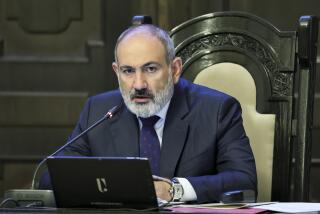U.N. Pushes Drug Interdiction in Former Soviet Central Asia
- Share via
TASHKENT, Uzbekistan — The United Nations’ top drug control official watched 14 metric tons of captured hashish go up in smoke here Saturday and rewarded this Central Asian nation with more money to fight narcotics bound for the streets of North America and Europe.
The hash, with an estimated street value of $650 million, was seized by the authorities as it entered Uzbekistan last year from neighboring Afghanistan. Thirteen tons came from one shipment destined for Belgium and Canada in trucks with cargo listed as nuts and raisins.
Inside the trucks, the drug was packaged in solid black slabs weighing a kilogram each, wrapped in plastic and labeled as French salad dressing.
Cardboard boxes full of the captured hashish were mechanically shoveled into a blazing furnace Saturday at an aluminum plant on the outskirts of Tashkent, the Uzbek capital.
Giorgio Giacomelli, executive director of the U.N. Drug Control Program, watched with satisfaction. He is touring Central Asian republics of the former Soviet Union on a mission to improve drug interdiction measures.
“In the short space of two years, we have noticed tremendous progress in the competence and disposition of the Uzbek authorities to deal with this growing problem,” he said.
Giacomelli signed an agreement to give Uzbekistan $500,000 over the next two years to help officials train narcotics officers, set up testing laboratories and prepare anti-drug legislation.
The five Central Asian republics--Uzbekistan, Turkmenistan, Kyrgyzstan, Tajikistan and Kazakhstan--occupy a vast region bordering Afghanistan, Iran and China.
The Afghan civil war and the collapse of border controls when the Soviet Union fell apart in 1991 has opened up the area as a route for smugglers from Afghanistan, one of the world’s largest producers of hashish, opium and heroin. Seizures as large as the 13-ton hashish shipment show the potential size of traffic through the region.
Besides the hashish burned here Saturday, Uzbek authorities say they have seized two tons of marijuana, heroin, opium and synthetic drugs since 1992.
But Giacomelli estimates that no more than 10% of the drug traffic through Central Asia is intercepted.
Bernard Frahi, head of the U.N. drug agency’s Europe and Middle East operation, said crime is getting more organized in the former Soviet Union, and Central Asia has the potential to produce its own narcotics.
Another danger is that drug abuse in Central Asia could grow.
“They must keep an eye on what is happening in nearby Pakistan and other such countries,” Giacomelli said. “Wherever there is heavy traffic, very soon there will be heavy abuse.”
More to Read
Sign up for Essential California
The most important California stories and recommendations in your inbox every morning.
You may occasionally receive promotional content from the Los Angeles Times.













